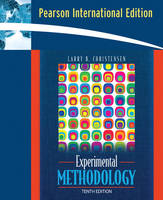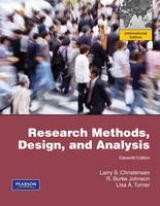
Experimental Methodology
Pearson (Verlag)
978-0-205-50467-1 (ISBN)
- Titel erscheint in neuer Auflage
- Artikel merken
Experimental Methodology is organized so that each chapter focuses on a specific step in the research process. The book provides instruction in experimental research as well as non-experimental approaches such as ex-post facto research, correlational research, and survey research. Also included are qualitative research approaches such as ethnography and phenomenology.
1. Introduction to Scientific Research
Chapter Review
Introduction
Methods
Tenacity
Intuition
Authority
Rationalism
Empiricism
Science
Induction
Hypothesis Testing
Naturalism
Kuhn and Paradigms
Lakatos and Research Programs
Feyerabend’s Anarchists Theory of Science
What is Science?
Pseudoscience
Overuse of ad hoc Hypotheses to Escape Refutation
Absence of Self-Correction
Reversed burden of Proof
Emphasis on Confirmation rather than Refutation
Overreliance on Testimonials and Anecdotal Evidence
Use of Obscurantist language
Absence of “Connectivity” with Other Disciplines
Advantage of Scientific Research
Characteristics of Scientific Research
Control
Operation
Replication
Objectives of Scientific Research
Description
Explanation
Prediction
Control
Basic Assumption Underlying Scientific Research
Reality in Nature
Rationality
Regularity
Discoverability
The Role of Theory in Scientific Research
The Role of the Scientist in Research
Curiosity
Patience
Objectivity
Change
Summary
Key Terms and Concepts
Related Internet Sites
Practice Test
Challenge Exercises
2. Nonexperimental Research Approaches
Chapter Preview
Introduction
Nonexperimental Quantitative Research
Correlational Study
Ex Post Facto Study
Longitudinal Study and Cross-Sectional Study
Naturalistic Observation
Meta Analysis
The Survey
Methods of Data Collection
Questionnaire Construction
Response Bias
Qualitative Research
Phenomenology
Ethnography
Ethnographic Methods
Entry and Group Acceptance
Data Collection, Analysis, Report Writing
Case Study
Summary
Key Terms and Concepts
Related Internet Sites
Practice Tests
Challenge Exercises
3. The Experimental Research Approach
Chapter Preview
Introduction
Causation
Cause
Effect
Causal Relationship
The Psychological Experiment
Advantages of the Experimental Approach
Causal Inference
Control
Ability of Manipulate Variables
Disadvantages of the Experimental Approach
Does Not Test Effects of Nonmanipulated Variables
Artificiality
Inadequate Method of Scientific Inquiry
Experimental Research Settings
Field Experimentation
Laboratory Experimentation
Internet Experiments
Summary
Key Terms and Concepts
Related Internet Sites
Practice Tests
Challenge Exercises
4. Problem Identification and Hypothesis Formation
Chapter Preview
Introduction
Sources of Research Ideas
Everyday Life
Practical Issues
Past Research
Theory
Gender Bias in Research Ideas
Ideas Not Capable of Scientific Investigation
Review of the Literature
Getting Started
Defining Objectives
Doing the Search
Books
Psychological Journals
Computerized or Electronic Databases
Internet Resources
Obtaining Resources
Additional Information Sources
Feasibility of the Study
Formulating the Research Problem
Defining a Research Problem
Specificity of the Question
Formulating Hypotheses
Summary
Key Terms and Concepts
Related Internet Sites
Practice Tests
Challenge Exercises
5. Ethics
Chapter Preview
Introduction
Research Ethics: What Are They?
Relationship between Society and Science
Professional Issues
Treatment of Research Participants
Ethical Dilemmas
Ethical Guidelines
Respect for Persons and their Autonomy
Beneficence and Nonmaleficence
Justice
Trust
Fidelity and Scientific Integrity
APA Ethical Standards for Research
Ethical Issues to Consider When Conducting Research
Institutional Approval
Informed Consent
Dispensing with Informed Consent
Informed Consent and Minors
Passive versus Active Consent
Deception
Debriefing
Coercion and Freedom to Decline Participation
Confidentiality, Anonymity, and the Concept of Privacy
Ethical Issues in Electronic Research
Informed Consent and Internet Research
Privacy and Internet Research
Debriefing and Internet Research
Ethical Issues in Preparing the Research Report
Authorship
Writing the Research Report
Ethics of Animal Research
Animal Rights
Alternatives to the Use of Animals
Safeguards in the Use of Animals
Animal Research Guidelines
Summary
Key Terms and Concepts
Related Internet Sites
Practice Tests
Challenge Exercises
6. Variables Used in Experimentation
Chapter Preview
Introduction
Types of Variables
The Independent Variable
Variation
Presence versus Absence
Amount of a Variable
Type of a Variable
Establishing Variation in the Independent Variable
Experimental Manipulation
Individual Difference Manipulation
Constructing the Independent Variable
Number of Independent Variables
The Dependent Variable
Response to be Used as the Dependent Variable
Reducing Participant Error
Number of Dependent Variables
Summary
Key Terms and Concepts
Related Internet Sites
Practice Tests
Challenge Exercises
7. Reliability and Validity in Experimental Research
Chapter Preview
Introduction
Relationship Between Reliability and Validity
Experimental Reliability
Reliability and the Number and Identification of the Participants
Reliability and the Ability and Characteristics of the Researcher
Reliability and the Independent Variable
Reliability and the Dependent Variable
Measurement Error
Methods of Assessing Reliability
Successive Measurement
Simultaneous Measurement
Internal Consistency
Experimental Validity
Statistical Conclusion Validity
Internal Validity
Threats to Internal Validity
History
Maturation
Instrumentation
Testing
Regression Artifact
Attrition
Selection
Additive and Interactive Effects
Summary
Key Terms and Concepts
Related Internet Sites
Practice Tests
Challenge Exercises
8. Construct and External Validity in Experimental Research
Chapter Preview
Introduction
Construct Validity
Assessing Construct Validity
Content Validity
Criterion-Related Validity
Other Sources of Evidence of Construct Validity
Threats to Construct Validity
Reactivity to the Experimental Situation
Participant Effect
Conditions Producing a Positive Self-Presentation Motive
Implication for Research
Experimenter Effects
Experimenter Attributes
Experimenter Expectancies
Mediation of Expectancy
Magnitude of the Expectancy Effect
External Validity
Population Validity
Ecological Validity
Temporal Validity
Treatment Variation Validity
Outcome Validity
Cautions in Evaluating the External Validity of Experiments
Relationship Between Internal and External Validity
Summary
Key Terms and Concepts
Related Internet Sites
Practice Tests
Challenge Exercises
9. Control Techniques
Chapter Preview
Introduction
Randomization
Matching
Matching by Holding Variables Constant
Matching by Building the Extraneous Variable into the Research Design
Matching by Yoked Control
Matching by Equating Participants
Precision Control
Frequency Distribution Control
Counterbalancing
Intrasubject Counterbalancing: The ABBA Technique
Intragroup Counterbalancing
Incomplete Counterbalancing
Control of Participation Effects
Double Blind Placebo Model
Deception
Procedural Control, or Control of Participant Interpretation
Control of Experimenter Effects
Control of Recording Errors
Control of Experimenter Attribute Errors
Control of Experimenter Expectancy Error
The Blind Technique
The Partial Blind Technique
Automation
Likelihood of Achieving Control
Summary
Key Terms and Concepts
Related Internet Sites
Practice Tests
Challenge Exercises
10. Experimental Research Design
Chapter Preview
Introduction
Research Designs with Threats to Internal Validity
One-Group Posttest-Only Design
One-Group Pretest-Posttest Design
Nonequivalent Posttest-Only Design
Requirements of Experimental Research Designs
Pretesting Participants
Experimental Research Designs
Posttest-Only Design
Between-Participants Posttest-Only Design
Within-Participants Posttest-Only Design
Combining Between- and Within-Participants Designs
Pretest-Posttest Design
Choice of a Research Design
Research Question
Control
Between-versus Within-Participants Design
Summary
Key Terms and Concepts
Related Internet Sites
Practice Tests
Challenge Exercises
11. Quasi-Experimental Designs
Chapter Preview
Introduction
Nonequivalent Comparison Group Design
Outcomes with Rival Hypohteses
Outcome I: First Increasing Treatment Effect
Outcome II: Increasing Treatment and Control Groups
Outcome III: Second Increasing Treatment Effect
Outcome IV: Crossover Effect
Causal Inference from the Nonequivalent Comparison Group Design
Time-Series Design
Interrupted Time-Series Design
Regression Discontinuity Design
Summary
Key Terms and Concepts
Related Internet Sites
Practice Tests
Challenge Exercises
12. Single-Case Research Designs
Chapter Preview
Introduction
Single-Case Designs
ABA Design
Interaction Design
Multiple-Baseline Design
Changing-Criterion Design
Methodological Considerations in Using Single-Case Designs
Baseline
Changing One Variable at a Time
Length of Phases
Criteria for Evaluating Change
Experimental Criterion
Therapeutic Criterion
Rival Hypotheses
Summary
Key Terms and Concepts
Related Internet Sites
Practice Tests
Challenge Exercises
13. Data Collection
Chapter Preview
Introduction
Research Participants
Obtaining Animals (Rats)
Obtaining Human Participants
Gender Bias
Sample Size
Power
Apparatus and/or Instruments
Instructions
Scheduling of Research Participants
Procedure
Pilot Study
Institutional Approval
Data Collection
Consent to Participate
Debriefing, or Postexperimental Interview
Debriefing Functions
How to Debrief
Summary
Key Terms and Concepts
Related Internet Sites
Practice Tests
Challenge Exercises
14. Hypothesis Testing
Chapter Preview
Introduction
Testing the Hypothesis
The Mean
Standard Deviation
Selection of a Statistical Test
Independent Samples t-Test
Significance Level
Analysis of Variance
One-Way Analysis of Variance
Analysis of Variance Summary Table
Interpreting the Results of the Analysis of Variance
Two-Way Analysis of Variance
Rejecting versus Failing to Reject the Null Hypothesis
Potential Error in the Statistical Decision-Making Process
Correlation
Computation in Correlation
Interpretation of Correlation
Summary
Key Terms and Concepts
Related Internet Sites
Practice Tests
Challenge Exercises
15. The Research Report
Chapter Preview
Introduction
The APA Format
Preparation of the Research Report
Writing Style
Language
Specificity
Labels
Participation
Specific Issues
Editorial Style
Italics
Abbreviation
Headings
Quotations
Numbers
Physical Measurements
Presentation of Statistical Results
Tables
Figures
Figure Captions
Reference Citations
Reference List
Typing
Ordering of Manuscript Pages
Submission of the Research Report for Publication
Acceptance of the Manuscript
Presenting Research Results at Professional Conferences
Oral Presentation
Poster Presentation
Summary
Key Terms and Concepts
Related Internet Sites
Appendices
A. Answers to Practice Tests
B. Critical Values of t
C. The 5 Percent and 1 Percent Values for the F-Distribution
D. Table of Random Numbers
References
Index
| Erscheint lt. Verlag | 20.7.2006 |
|---|---|
| Sprache | englisch |
| Maße | 189 x 249 mm |
| Gewicht | 810 g |
| Themenwelt | Geisteswissenschaften ► Psychologie |
| ISBN-10 | 0-205-50467-1 / 0205504671 |
| ISBN-13 | 978-0-205-50467-1 / 9780205504671 |
| Zustand | Neuware |
| Haben Sie eine Frage zum Produkt? |
aus dem Bereich



